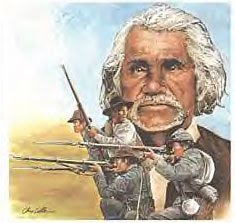JUNE
23, 1865:
General Stand Watie,
the highest-ranking Native American Confederate General, surrenders his troops
in the Indian Territory.
Although
most historians consider Stand Watie’s surrender to have put a final imprimatur
on the Civil War, like so many other “lasts” of the Civil War this “last” is
only the beginning of a series of occurrences. Over the next several weeks,
other groups, bands, and tribes of Indians lay down their arms.
Though
the word “surrender” is used to describe Stand Watie’s action this day, his
decision to cease fighting (and other similar decisions taken by other Native
American leaders subsequently) is more complicated than a simple “surrender.”
It should be remembered that the Indian Tribes were not generally units of the Confederate military but were allies of the Confederacy. Their
“surrenders” took several forms (or combinations of forms):
1. Small
groups or bands of men would present themselves to a Federal Indian Agent and
lay down their arms and / or battle flags.
2. Larger
bands or tribes would meet in council and vote to abrogate their treaties with
the defunct Confederacy, electing to reinstate their preexisting treaties with
the United States, at which point Federal Agents were so advised.
3. Tribes would renegotiate
new treaties with the United States. Since any new treaties had to be ratified
by Congress, a technical state of war continued to exist between the U.S. and
the tribe until such ratifications were finalized. This process could take
months, and so the Civil War did not end de
jure until 1866.
Among
the tribes were those that continued to fight. Whether they were fighting for
the Confederacy or for themselves made little difference in a practical sense.
Although this is an interesting historical niche question, such ongoing
conflicts were described by Federal troops as actions by “renegades” and were
subsumed under the rubric of the “Indian Wars” even when individual Indian
soldiers wore gray or flew their Confederate battle flags.

No comments:
Post a Comment